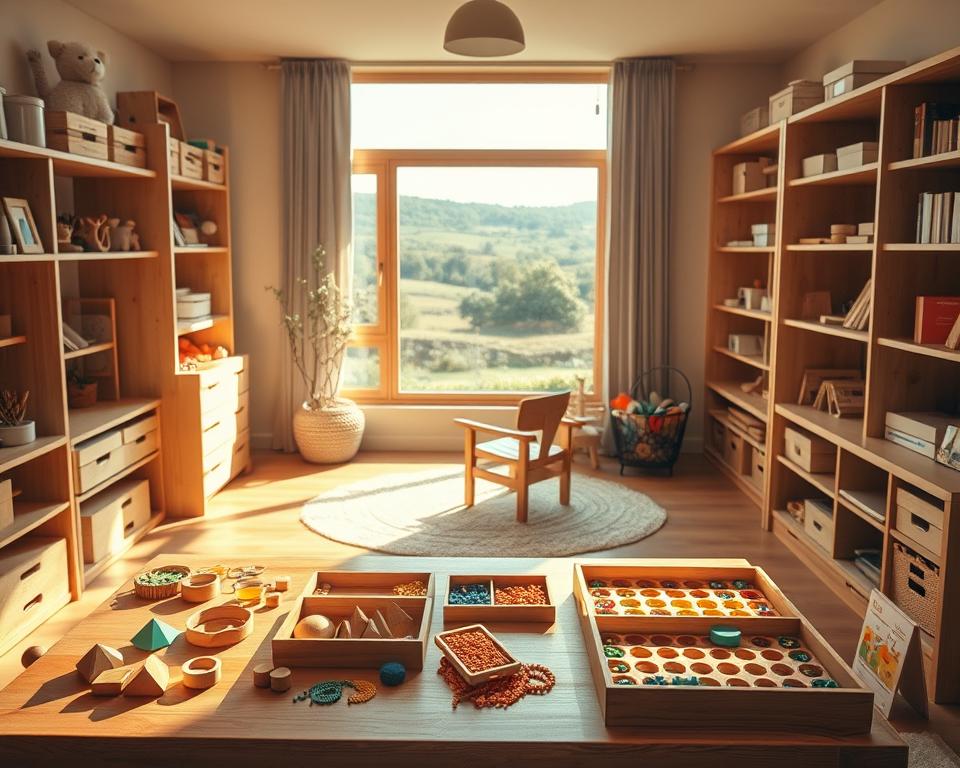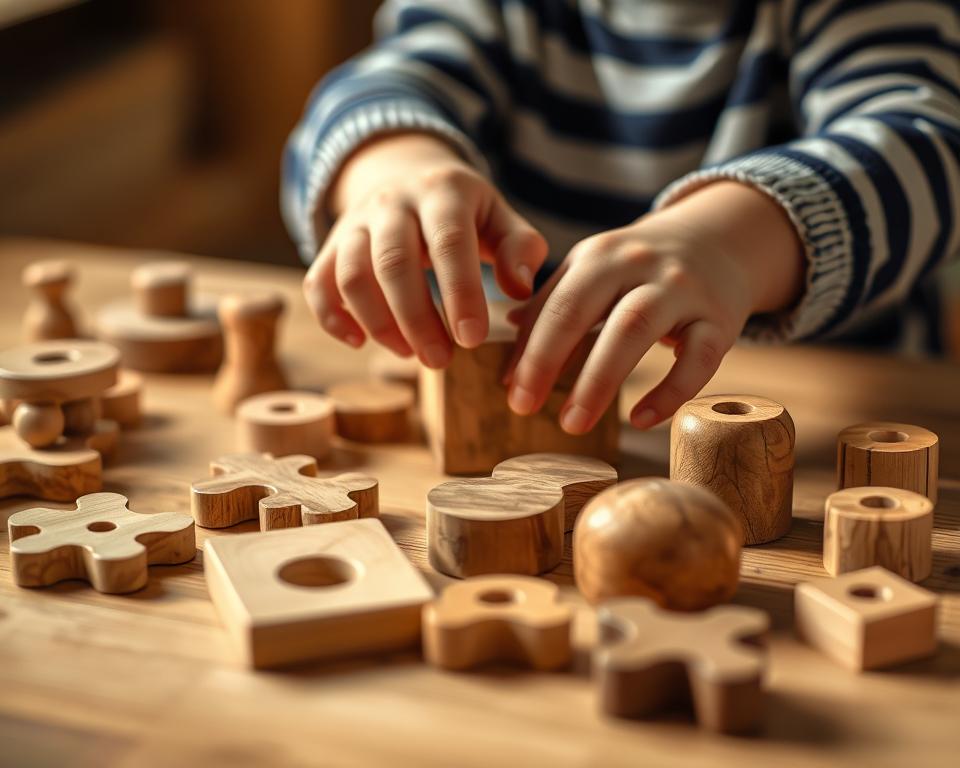Have you ever wondered how simple, everyday tasks can shape a child’s independence and confidence? From buttoning a shirt to pouring water, these seemingly small actions play a big role in development.
Wooden tools and hands-on learning are at the heart of this approach. They provide a tactile experience that helps children refine their fine motor skills and coordination. These activities aren’t just about completing tasks—they’re about building essential life skills in a nurturing way.
By engaging in these tasks, children learn to care for themselves and their environment. They gain a sense of responsibility and accomplishment, which boosts their confidence. This method mirrors real-life scenarios, making learning both meaningful and enjoyable.
Key Takeaways
- Wooden tools enhance tactile learning and skill development.
- Hands-on tasks foster independence and confidence in children.
- Fine motor skills are improved through everyday activities.
- Children learn responsibility by caring for themselves and their surroundings.
- These activities create a foundation for lifelong learning.
Introduction to Practical Life with Wooden Activities
Children learn best when they engage in hands-on, real-world experiences. These routines, often overlooked, are the building blocks of independence and confidence. From washing hands to setting the table, these tasks teach self-care and organization in a meaningful way.
What Defines Practical Life?
Practical life encompasses everyday routines that help children develop essential skills. These tasks include washing, organizing, and caring for their environment. By focusing on these activities, children learn to take responsibility and build coordination.
These routines are not just about completing tasks. They are about fostering a sense of order and concentration. Children gain confidence as they master each step, preparing them for more complex challenges.
The Role of Wooden Tools in Montessori Education
Wooden tools play a vital role in this learning process. They provide a tactile experience that enhances care and precision. For example, using a wooden spoon to stir or a small brush to clean helps children refine their motor skills.
These tools are designed to be child-friendly and safe. They encourage children to take ownership of their work, fostering independence. By engaging with these materials, children develop a deeper understanding of their tasks.
Whether it’s setting the table or washing dishes, wooden tools make learning enjoyable. They bridge the gap between play and real-life skills, creating a foundation for lifelong learning.
Deep Dive into practical life montessori activities
What role do structured tasks play in a child’s development? These routines are more than just chores—they’re stepping stones to independence and confidence. By engaging in hands-on tasks, children build essential skills that prepare them for future challenges.

Understanding Child Development and Prepared Environments
A prepared environment is key to fostering growth. It’s designed to encourage exploration and independence. When children interact with their surroundings, they develop a sense of order and responsibility.
Tasks like brushing or preparing food are more than just routines. They help refine fine motor skills and improve coordination. These activities also teach children to focus and follow steps, which are crucial for learning.
Here’s how structured tasks benefit children:
- They build confidence through mastery of skills.
- They promote concentration and attention to detail.
- They encourage independence by allowing children to take charge of their tasks.
For example, washing dishes or setting the table teaches organization and teamwork. These real-life examples make learning meaningful and enjoyable. By engaging in these tasks, children develop a sense of accomplishment that boosts their self-esteem.
Montessori experts emphasize the importance of these activities. They believe that structured learning prepares children for academic success. By focusing on order and task management, children gain the skills they need to thrive.
Setting Up a Child-Friendly, Prepared Environment
Creating a space where children can thrive independently starts with thoughtful design. A well-organized environment encourages exploration and helps children take ownership of their tasks. Whether at home or in the classroom, every part of the space should inspire curiosity and independence.
Designing an Organized Space at Home and in the Classroom
One way to foster independence is by making materials accessible. Use low shelves and child-sized furniture to create a space where children can easily reach what they need. This setup teaches them to manage their own tasks without constant assistance.
Another key thing is to keep the environment orderly. Assign a specific place for each item, so children learn to respect and maintain the space. For example, a designated area for wooden tools or art supplies helps them understand organization.
Balancing structure with freedom is essential. While it’s important to have clear guidelines, children should also feel free to explore and make choices. This approach teaches them to take initiative while respecting boundaries.
Here are some tips to create a child-friendly space:
- Use natural materials like wood to create a warm and inviting atmosphere.
- Incorporate real-life objects, such as small brooms or ceramic bowls, to teach practical skills.
- Keep the space clutter-free to promote focus and concentration.
By designing a prepared environment, we give children the tools they need to succeed. Over time, they develop confidence and a sense of responsibility, which are essential for their growth.
Engaging Hands-On Activities: A How-To Guide
Simple wooden tools can transform learning into a fun, interactive experience. These setups are designed to help children develop essential skills while enjoying the process. Whether it’s washing dishes or folding clothing, these tasks are more than just chores—they’re opportunities for growth.

Step-by-Step Instructions for Wooden Activity Setups
Start by gathering the necessary materials. For example, a small wooden tray, a sponge, and a ceramic bowl are perfect for a dish-washing station. Arrange these items in an organized way to encourage focus and independence.
Next, demonstrate the task slowly and clearly. Show how to dip the sponge, scrub the bowl, and rinse it off. Let the child observe before they try it themselves. This step-by-step approach builds confidence and ensures they understand the process.
For younger children, tailor the activity to their age and ability. Use larger tools or simplify the steps to make it more manageable. For example, a smaller bowl or a simpler folding task for clothing can make the activity more accessible.
Tips for Encouraging Independent Learning
Encourage children to take charge of their tasks. Offer guidance when needed, but let them explore and make mistakes. This fosters problem-solving skills and builds resilience.
Use visual cues like checklists or picture guides to help them remember the steps. For example, a chart showing how to set the table or water a plant can be a great reference tool.
Praise their efforts, not just the results. Celebrate small victories, like successfully folding a shirt or washing a dish. This positive reinforcement boosts their confidence and motivates them to keep trying.
Here are some key tips to keep in mind:
- Keep materials accessible and organized to promote independence.
- Tailor activities to the child’s age and skill level.
- Use real-life examples, like washing dishes or folding clothing, to make learning relatable.
- Focus on building fine motor skills through hands-on tasks.
By following these steps and tips, you can create an engaging and effective learning environment. These activities not only teach essential skills but also empower children to take pride in their work.
Benefits of Practical Life Activities for Child Development
Small routines hold the key to big developmental milestones. These everyday tasks, often overlooked, play a significant role in shaping a child’s growth. From handling materials to organizing items, these activities build essential skills that last a lifetime.
Enhancing Fine Motor Skills and Coordination
Activities like pouring water or using wooden tools help children refine their fine motor skills. These tasks require precision and control, which strengthen hand-eye coordination. Over the year, these skills become the foundation for more complex tasks like writing or tying shoelaces.
For example, arranging items on a tray or threading beads teaches children to focus and follow steps. These activities not only improve coordination but also boost concentration. Such skills are crucial for success in the classroom and beyond.
Building Confidence and a Sense of Order
When children complete tasks independently, they gain a sense of accomplishment. This builds their confidence and encourages them to take on new challenges. Simple routines, like setting the table or watering plants, teach responsibility and respect for their environment.
These activities also foster a sense of order. By assigning a specific place for each item, children learn to organize their space. This structured approach helps them feel secure and in control, which is essential for emotional growth.
Studies show that children who engage in these tasks develop better problem-solving skills. They learn to make intelligent choices and persist through mistakes. These qualities prepare them for academic and social success in the years to come.
By incorporating these activities into daily routines, we provide children with valuable learning opportunities. Whether at home or in the classroom, these tasks empower them to grow into confident, capable individuals.
Conclusion
Every small step a child takes builds their confidence and independence. Using wooden tools and hands-on exercises, we help them develop essential skills. These tasks go beyond the classroom, influencing every part of their daily development.
From organizing clothes to completing simple chores, children learn responsibility and focus. These exercises improve coordination and concentration, preparing them for future challenges. By encouraging independence, we nurture not just physical skills but emotional growth too.
We invite you to join us in creating spaces where children can thrive. Share your experiences and become part of a community dedicated to fostering lifelong learning. Together, we can help children take pride in their development and achievements.
FAQ
What are the key benefits of using wooden tools in early learning?
Wooden tools help children develop fine motor skills, hand-eye coordination, and a sense of independence. They also provide a natural, durable, and safe option for hands-on exploration.
How can I create a prepared environment at home for my child?
Start by organizing a space with child-sized furniture and accessible materials. Keep items like brushes, dishes, and clothing within reach to encourage self-care and responsibility.
What types of tasks are best for building a child’s confidence?
Simple tasks like washing dishes, preparing food, or caring for plants allow children to practice real-world skills. These activities foster independence and a sense of accomplishment.
How do hands-on activities support a child’s development?
Activities like window washing or table setting enhance concentration, coordination, and problem-solving. They also teach order and responsibility in a fun, engaging way.
At what age should I introduce practical tasks to my child?
You can start as early as 2-3 years old with basic tasks like pouring water or brushing clothes. Adjust the complexity as they grow to match their abilities.
How can I encourage my child to work independently?
Provide clear, step-by-step instructions and demonstrate tasks first. Use materials like wooden tools that are easy to handle, and offer praise to build their confidence.
What’s the importance of order in a child’s learning environment?
An organized space helps children focus and understand routines. It also teaches them to care for their surroundings and develop a sense of responsibility.
